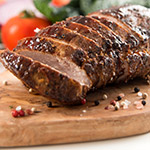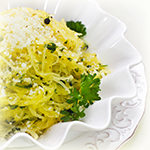Are you ready to get to know Atkins? It’s time to clear up a couple misconceptions that I hear about Atkins all the time…
Atkins is Not a “No Carb” Diet
Yes, Atkins is considered a low carb diet, but this does not mean you aren’t eating any carbs. You are just changing the types of carbs that you eat. You are swapping sugar and processed foods—those empty carbs that mess with your blood sugar and energy levels—for fiber-rich vegetables and even whole grains. Even from the beginning, you are eating more vegetables than the average American, for five very good reasons. And if you choose to do Atkins 40 or Atkins 100, no food (except for sugar and processed foods, which you shouldn’t be eating anyway) is off limits… potatoes and pasta (in certain amounts) is fair game from the start.
Atkins is Not a High Protein Diet
I prefer to consider Atkins an optimal protein diet. Based on most heights and gender, it’s recommended that you consume 4 to 6 ounces of protein at each of your meals each day. If you are a tall male, you might want to go with 8 ounces of protein, but the 4- to 6-ounce range should work for the majority of folks. The ideal amount of protein should make you full after your meal (not uncomfortably stuffed, though), but hungry in time for your next scheduled meal. On an average day, you’ll consume between 12 and 18 ounces (cooked weight) of protein. When combined with healthy fats and fiber-rich vegetables, protein keeps you satisfied, plus digesting and metabolizing protein burns twice the calories than when you eat carbohydrates.
Eyeball Your Protein Portions With These Guidelines
|
4 ounces meat, poultry, tofu, etc. |
Smartphone |
|
6 ounces meat, poultry, tofu, etc. |
Hockey puck |
|
8 ounces meat, poultry, tofu, etc. |
Slim paperback book |
|
3 ounces fish |
Checkbook |
|
1 ounce hard cheese |
Four dice or the size of an individually wrapped slice |
Low Carb Recipes Rich in Protein and Full of Flavor
Try these delicious low carb fall dishes, which feature protein, fiber-rich veggies and healthy fats:

Balsamic Pork Loin with Roasted Rosemary
Kick off the fall season with this hearty dish. Savory pork loin is marinated in tangy balsamic vinegar and heart-healthy olive oil, while roasted cauliflower is naturally low in carbs but full of taste, and an excellent swap for potatoes, which are higher in carbs.

Spaghetti squash is a fall favorite, and this bright salad pairs well with any protein, such as chicken and fish, for a perfectly balanced meal.